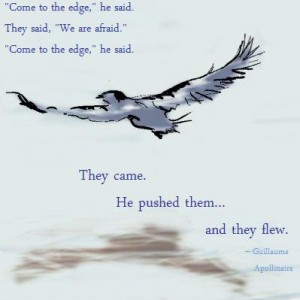The subject of State-Of-Being verbs has occupied a large swath of both my writing and my editing radars lately.
The culprits: Am, is, are, was, were, to be, had been, etc.
These dullards convey no action at all. They simply are. They convey a state of being, and nothing more. Say it with me now: Boring!
Let’s not forget the SOB verbs’ evil cousins, the DIA verbs (Dull InActive verbs).
The culprits: Did, had, went, came, got, took, kept, made, put, had*, etc. *Exception: The necessary use of “had” in Past Perfect Tense.
When employing these verbs, you’re indicating that something is happening, but that something evokes no imagery in the reader’s mind, no sense of action or urgency. Dull!
The reason these inactive verbs remain so anathema to effective writing relates to one of the primary commandments of writing: SHOW; DON’T TELL.
A reader enjoys most what she sees in her mind’s eye. If your prose evokes no imagery, if you fail to paint a picture with your words, the reader will never enter the scene as if she were a spectator or, better yet, living vicariously through the characters.
If you fail in this regard, you offer only the fictional equivalent of a lecture. Bluch!
Therein lurks the danger of SOB and DIA verbs. Yes, they are occasionally required, but I’ll bet a dollar to your dime that you can eliminate half of them from your manuscript. You must challenge yourself, and exercise the creativity that drove you to write in the first place. Evoke an image by using a verb that conveys action.
To do so, you’ll have to rethink your sentence structure—perhaps the entire paragraph. So what? Your job—indeed, your covenant with the reader—is to bring her into a fictional world where she can escape her real-worldly burdens for a while. Why else would she read your story? Your continued success rests on how well you meet your obligation.
Remember this as you restructure your sentences to make them active: Keep it strong and direct! No Passive Voice allowed. Why trade one weak sentence for another?
So get busy searching your document for all those nasty SOB and DIA verbs. Count them (let your software’s “find” function do that) and list the numbers now, and again after you’re revised the manuscript. How many did you cut?
I’ll visit the related subject of weak/lazy/overused words in the near future. Geez! This writing thing is hard.
‘Til next time, and as always, remember: To write well, you must work hard. To succeed in this tough gig, you mustn’t be lazy (or discouraged).
———-




I have a question. How about the use of these banned words in dialogue? For example, how many people say, “I achieved the “A” list?” Rather, real people say, “I made the “A” list.” Or, imagine this dialogue: “Who created these cookies for the kids?” the teacher asked.
“My mom fashioned these cookies,” replied four-year-old, Daisy.
“They be ornate,” the teacher enthused.
“She labored three hours and fifteen minutes decorating them,” Daisy explained.
Sometimes authors agonize over showing rather than telling, and I can tell. And sometimes their “showing” leaves me completely in the dark about that they’re getting at. The point of the story is so obtuse, I want to set my hair on fire, and I stop reading.
Also, how do you “show” a .45 caliber pistol? For example:The gunshot left a three-inch exit wound and the cops knew why. The weapon was powerful and the bullet was ejected from a long barrel. Wouldn’t it be easier to just say: Ballistics tests proved Joe was plugged by a .45?
Yeah, I get it. No information dumps allowed, but sometimes the best way to tell a tale is to get on with it. Do I care if Scarlet’s dress has 4000 polka-dots on it? Do I care if Scarlet’s dress sports 4000 polka-dots embellished on its woven surface? The answer in no in both cases.
One more thing: it would really be helpful if you included examples of what you’re talking about by presenting a sentence you judge boring, and how you would liven it up.
Jenean, at the heart of it all, especially for dialogue (but I would also argue for the main narrative), the prose must “sound” and feel natural. People talk like people talk, and if you suddenly try to make a young Daisy sound like and old Shakespeare, readers will revolt. Keep it strong and visual, but also keep it NATURAL.
So here are a couple of examples:
LAZY: The lighting was dim and the only sound he heard was the piped in elevator music that played in a seemingly endless loop.
STRONGER: Dim lighting deepened the sullen mood as piped-in elevator music played in an endless loop.
LAZY: The sky was a brilliant blue with a few white wisps scattered here and there. Her long smooth legs were warm from the sun.
STRONGER: Sunlight, broken occasionally by scattered white wisps, radiated through a brilliant blue sky and bronzed her long, smooth legs.
For this next one, it may seem innocuous enough, and if the rest of the writing around it is strong, perhaps it will suffice. Yet when the piece is laden with such sentences, it becomes a real problem.
LAZY: He was by far the tallest person in the meeting room.
STRONGER: He towered above the others in the meeting room as if they’d all skipped over from the local chapter of the Lollipop Guild.
We typically have many, many options for providing a more visual and powerful scene. You might choose an entirely different option than I did, and that’s fine — a matter of stlye and voice — so long as it accomplishes the primary goal of giving the reader something stronger and more compelling to see in their mind’s eye.
If you want readers to get to the end of your book and say, “Yeah, it was okay,” then the LAZY options may be fine. If you want them to say, “Wow, that was really something!”… well, I recommend stronger options, and falling into a constant “was [adjective]” mode is the enemy.
I hope that helps.
Also check out tools such as Pro Writing Aid, which has a free version that can highlight SOB verbs (and other weak constructs). Sometimes, they’re hard to pick out, but if they’re color-coded, it’s easier to see how many there really are.
Indeed, Darren. I do this manually through the MS Word FIND ALL function. In fact, I do this with all my “Lazy Words” when writing a story. And don’t ask me how many Lazy Words I have. (Too many!) 🙂